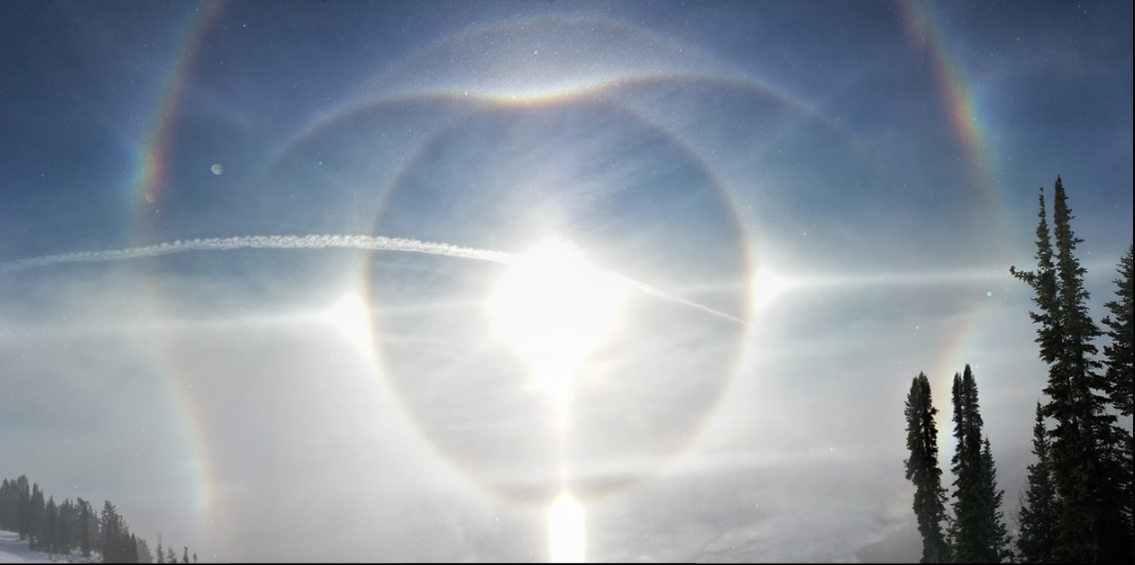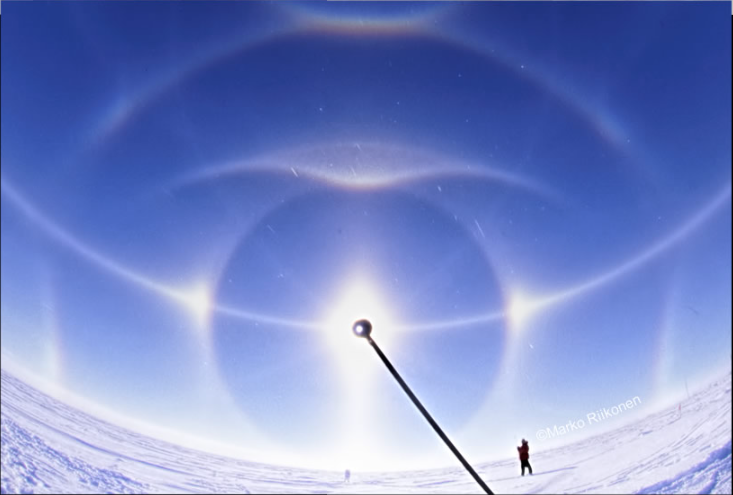Jackson Hole Ice Halo Display - OPOD
Jackson Hole Ice Halo Display - A Spectacular Natural Phenomenon
Ice halos are a captivating atmospheric optics phenomenon that can create a stunning display of rare halos. One such mesmerizing display occurred in Jackson Hole, captured by Stephen Lyons on December 3rd, 2015. This remarkable event showcased a variety of halos, including Parry infralaterals and Lowitz arcs. Let's delve deeper into the intricacies of this fascinating natural occurrence.
Ice crystals, the building blocks of ice halos, form on tiny nuclei suspended in the atmosphere. These nuclei can be airborne sea salt, dust particles, or aerosols. The growth of ice crystals is influenced by various factors, including temperature, humidity, and other parameters that are not yet fully understood. Interestingly, the slower the crystal growth, the more perfect its eventual shape becomes.
In ski resorts, snow blowers play a significant role in promoting snowflake formation on ski slopes. As a by-product of this process, near optically perfect halo-forming ice crystals are emitted. These crystals grow slowly downwind of the snow formation area. The Jackson Hole ice halo display was a result of these unique conditions. The presence of ski-slope snow blowers led to the formation of helic and 46° Parry arcs, which are exceptionally rare and were previously only observed in exceptional displays at the South Pole.
However, what sets the Jackson Hole display apart is the presence of Lowitz arcs in ski-slope diamond dust. These arcs are not commonly observed in such settings, making this particular event even more extraordinary.
To gain further insight into the formation of these rare arcs in both the Jackson Hole and South Pole displays, it is helpful to compare them. In 1999, Marko Riikonen captured a similar display at the South Pole on film. Interestingly, there were no snow blowers present at the South Pole, yet the crystal structures were remarkably similar. The primary difference lay in the nuclei on which the ice crystals formed.
It is important to note that the Jackson Hole Ice Halo Display is just one example of the captivating atmospheric optics phenomena that occur around the world. These displays serve as a reminder of the intricate and awe-inspiring beauty of nature. By studying and understanding these phenomena, scientists can gain valuable insights into the physics of light and atmospheric conditions.
In conclusion, the Jackson Hole Ice Halo Display was a breathtaking showcase of rare halos, including Parry infralaterals and Lowitz arcs. The presence of ski-slope snow blowers played a crucial role in creating these stunning optical phenomena. Comparisons with displays at the South Pole revealed similarities in crystal structure, highlighting the significance of nuclei in determining the characteristics of ice crystals. These displays serve as a testament to the wonders of nature and the complexity of atmospheric optics.

Jackson Hole Ice Halos ~ A magnificent display of rare halos including Parry infralaterals and Lowitz arcs. Captured by Stephen Lyons while skiing on 3rd December '15. See below for halos labelled on a colour subtraction enhancement and also a comparison with halos at the South Pole where there are skiers but no ski slope snow blowers! Image ©Stephen Lyons

Ice crystals grow on tiny nuclei, airborne sea salt, dust, aerosol etc. In general, the slower the crystal growth the more perfect the eventual crystal. The crystal shape or habit (hexagonal plate, column, pyramidal) depends in a poorly understood way on temperature and humidity amongst probably many other parameters.
Ski-slope snow blowers emit special nuclei to promote snowflake formation. A by-product is near optically perfect halo forming crystals. They grow slowly downwind of the snow formation.
The Jackson Hole display came from them. The helic, 46° Parry arcs are rarities that before snow blowers were only seen in exceptional displays at the South Pole. But the Lowitz arcs are unusual in ski-slope diamond dust.

Compare with a similar South Pole display imaged in 1999 on film by Marko Riikonen.
There are no snow blowers there. However, the crystals are the same - only their nuclei differ.
Go here for a how the rare arcs in both displays formed.
Note: this article has been automatically converted from the old site and may not appear as intended. You can find the original article here.
Reference Atmospheric Optics
If you use any of the definitions, information, or data presented on Atmospheric Optics, please copy the link or reference below to properly credit us as the reference source. Thank you!
-
<a href="https://atoptics.co.uk/blog/jackson-hole-ice-halo-display-opod/">Jackson Hole Ice Halo Display - OPOD</a>
-
"Jackson Hole Ice Halo Display - OPOD". Atmospheric Optics. Accessed on November 24, 2024. https://atoptics.co.uk/blog/jackson-hole-ice-halo-display-opod/.
-
"Jackson Hole Ice Halo Display - OPOD". Atmospheric Optics, https://atoptics.co.uk/blog/jackson-hole-ice-halo-display-opod/. Accessed 24 November, 2024
-
Jackson Hole Ice Halo Display - OPOD. Atmospheric Optics. Retrieved from https://atoptics.co.uk/blog/jackson-hole-ice-halo-display-opod/.